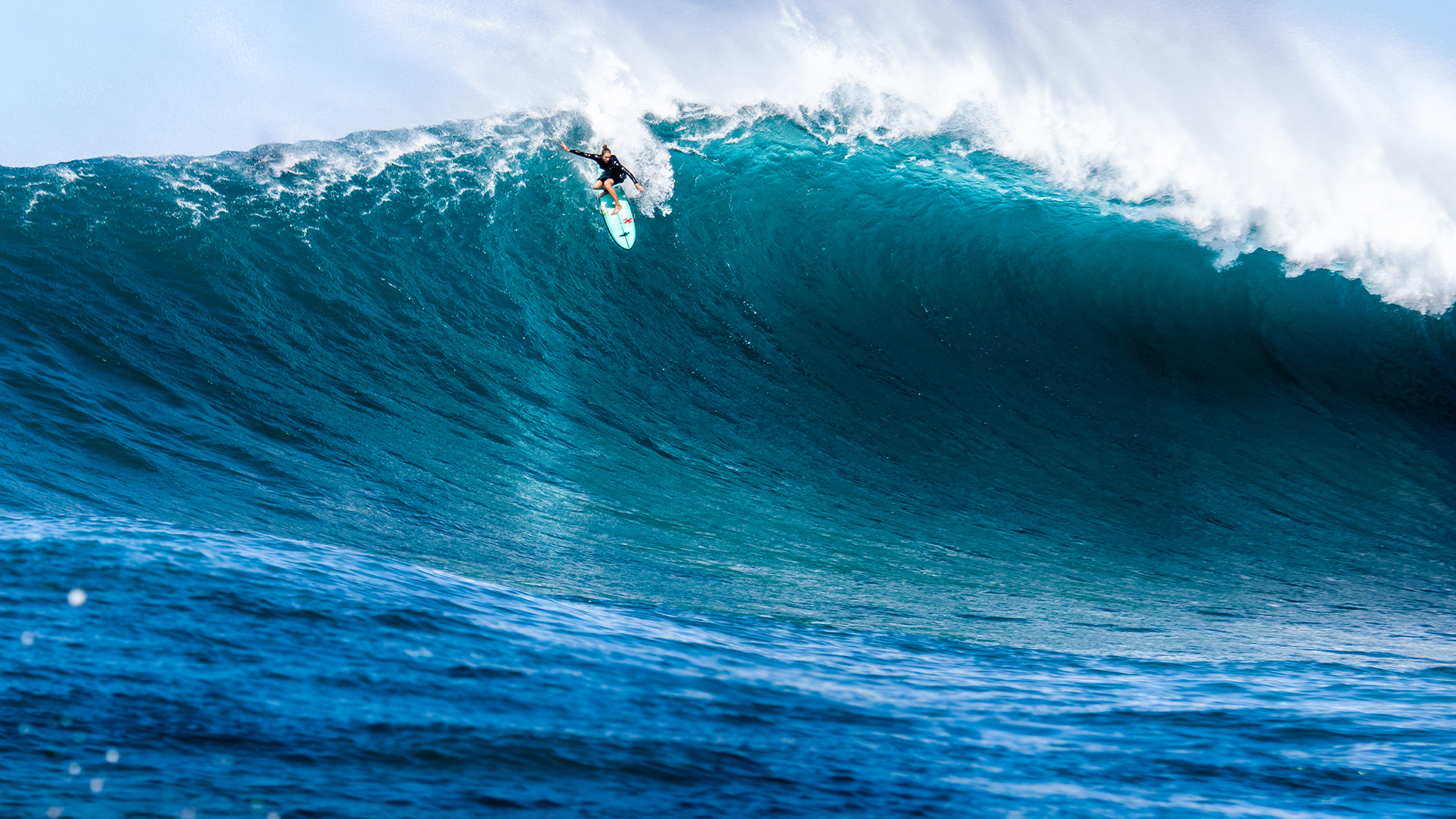Over the last few years, waves of change have rocked the surfing world, especially for Hawai‘i and women athletes.
Images by Christa Funk
Born and raised in the ahupua‘a of Waikīkī, near the fabled shoreline once graced by the beach homes of Hawaiian chiefs, I took up surfing in the late 1960s as a young teen and have been obsessed with it ever since. If I’d had any real athletic talent, not been so averse to cold water that I quit my Northern California college surf club, and been able to find work in Hawai‘i instead of having to move to New York City, I could easily have become my family’s worst nightmare: a surf bum.
After all, I went surfing in a Kamehameha Day swell the morning of my wedding, and got back so late, I walked down the aisle with dripping hair. While living for decades in NYC, writing and editing for a living, I swam in city pools to stay in shape for the two weeks a year my husband, Don Wallace, our son, Rory, and I spent visiting family on O‘ahu. Sometimes we’d arrive at the end of a big swell and leave just as a new one was rolling in for me to gaze upon with frustration as our airplane dipped a wing towards Diamond Head for a farewell look.
Although we lived in Lower Manhattan without a car, once in a while our uptown writer friend William Finnegan, author of Barbarian Days: A Surfing Life, would load our boards and fins into his station wagon and drive to Long Island, where we’d tackle the dirty gray waves breaking off the rock groins of Long Beach, or the clean, turquoise cylinders rolling over the sandbars of East Hampton and Montauk. A couple times, Don and I even took the subway to the crowded Rockaways.
I was never as obsessed with surf as Bill, who chased big waves from Fiji to Madeira. But when I met him for the first time (he and Don had been classmates at U.C. Santa Cruz), I learned we shared surfing origins. Bill had, for a time in his teens, lived in my Honolulu neighborhood and surfed the same stretch of breaks: Suis, Graveyards, Radicals, The Winch, Ricebowls, Tongg’s. Although we had somehow never met at the time, he had known and surfed with my friends and mentors, the boys of the Tongg’s Gang.
During the ‘60s, I would hear about Hawai‘i female surfers who were competing on the nascent amateur and professional circuits of the time, but we never saw them surfing in magazines or films. In 1963, Californian Linda Benson was the first woman to appear on a surf magazine cover, but it didn’t show Benson riding a wave. It’s a portrait shot of the petite but powerful blonde, her hair in a Jean Seberg pixie cut, holding her board as she stands on land.


As a teenager, I assumed that surfing, like most other sports and professions, had always been male-dominated. I was hopeful that, as the feminist movement gained momentum and won demands for equal opportunity, there would soon be as many women surfing as men. I was wrong.
After more than 30 years on the continent, I moved home to Hawai‘i in 2009, and for the first time since high school, I have the joy of surfing year-round, without sadly counting the days left in my visit every time an outward-bound jet flies overhead. I began writing a newspaper column on surfing, which grew into my book, Surfing Sisterhood Hawai‘i: Women Reclaiming the Waves. I have been happy to see more females in the lineup than when I was a girl, but alarmed to witness far more overt, gender-based intimidation and insulting, dismissive behavior from males. A booming sport since the mid-20th century, surfing, even in its everyday, supposedly “fun” form, has gotten exponentially more crowded and competitive, which stokes some men’s frustration and aggression.
Worldwide, as of 2016, there were an estimated 33 million surfers, with males outnumbering females by males 4-1, according to the International Surfing Association. But in Hawai‘i, the average ratio that I and other women observe is more like 8-1. Meanwhile, competitive surfing allots places to half as many female as male contestants, from amateur keiki events to the elite big wave and world championship pro tours. To date, only surfing’s Olympic debut — in the 2020 Tokyo Summer Games, where Hawai‘i’s Carissa Kainani Moore won gold — has fielded equal numbers of women and men.
Hawai‘i’s women surfers are reclaiming our traditional rights in the waves, and joining their colleagues worldwide in shredding male chauvinist myths that we can’t execute advanced maneuvers, such as getting tubed or exploding into the air above the tops of the waves, or ride big waves, as well as men. “When I was a little girl, I was told that women can’t surf,” Kaua‘i native Keala Kennelly said in 2016, “and I was told this about getting barreled, surfing big waves, surfing Pipeline, paddling in at Jaws, and the list goes on.” She had just become the first woman to win the open-gender, Pure Scot Barrel of the Year Big-Wave Award.
Over the last few years, waves of change have rocked the surfing world, especially for Hawai‘i and women athletes. In response to women surfers’ demands for equal opportunity, the World Surf League began paying equal prize money to women and men in 2019; and, following passage of a “surf equity bill” by the Honolulu City Council in 2020, the city’s Department of Parks and Recreation is revising its permitting rules for surf meets at O‘ahu beach parks, adding gender equity as a criterion. In 2022, the World Surf League Championship Tour began fielding men’s and women’s events at the same venues, including O‘ahu’s Pipeline and Sunset Beach. Last January, women competed for the first time, alongside the men, in the 37 years of the Eddie Aikau Big-Wave Invitational at Waimea Bay.
Women recreational surfers are also fast overcoming the discrimination that has held us back since Westerners invaded the islands, decimating the original population with introduced disease; illegally overthrowing and annexing the sovereign Hawaiian nation; causing impoverishment and starvation through the taking of lands and fishing rights; and suppressing the language and traditional practices, including surfing, which Protestant missionaries tried to ban. For more than 50 years, since the Hawaiian Renaissance of the 1960s and ‘70s, Native Hawaiians have been working to revive, restore, and steward their history, culture, health, prosperity, lands, and natural resources — and women surfers have been reclaiming the waves.
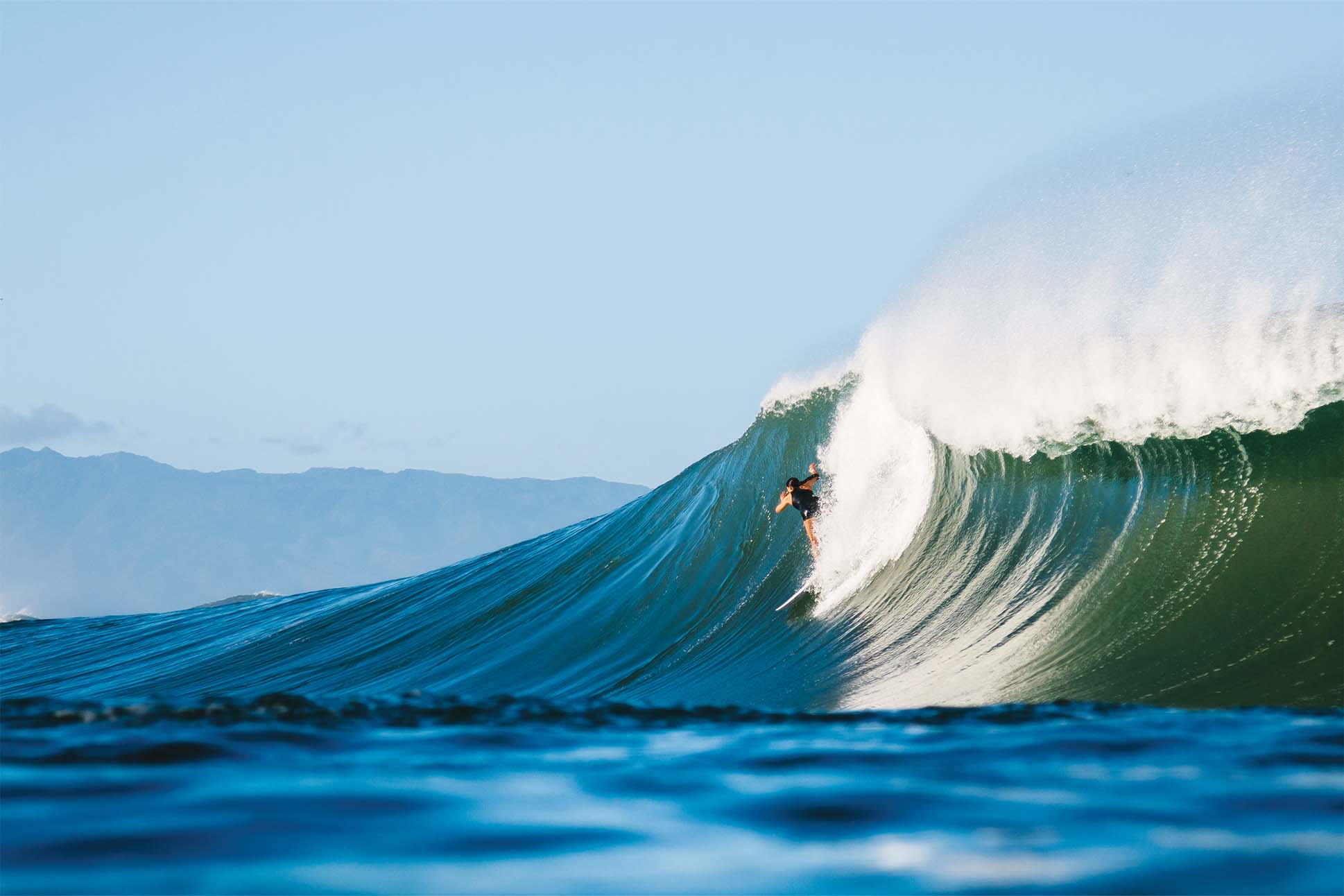

In Hawaiian history, legends, and 19th-century newspapers, women not only surfed in great numbers, but often ruled the waves. Although not allowed to eat with men and faced other gender-based restrictions under the traditional kapu system, when they got out in the ocean, Hawaiian women were free.
“The entire female population of Kealakekua plunged entirely naked into the waves” atop six- to eight-feet-long pointed boards and rode “upon the foaming crest of the surges,” writes Theodore-Adolphe Barrot in his Visit of the French Sloop of War Bonite, to the Sandwich Islands in 1836. “Women not only surfed, but surfed as well as men,” or better, according to Hawaiian waterman and historian John Clark in Hawaiian Surfing: Traditions from the Past.
Clark cites a newspaper account of a Kamehameha Day surf contest at Lahaina, Maui, on June 11, 1887, in which a man named Poepoe was favored to win. His wife Nakookoo also competed. As her husband rides a wave, Nakookoo “shoots like a flying fish through the whitening foam, jostles the champion on his wonted plank of victory, and came in foremost amid the outcries of a delighted multitude glad that the woman had won.” The writer added that Nakookoo, while still beautiful, was not in her first youth, so it’s also a win against ageism. “As far as I know, this is the first description in English of a surfing contest, and it was won by a woman,” Clark told me. He points out that women also got barrelled, as observed by Barrot: “The least movement of their body gave to the plank the desired direction, and disappearing for a moment in the midst of the breakers, [the women] very soon arose from the foam.” Clark calls this “the earliest description by a Westerner of tube-riding, the radical maneuver that is commonly assumed to be a 20th-century invention.”
Many of the most famous surfers in Hawaiian legend and history were female, starting with volcano goddess Pele and her sister Hi‘iaka, goddess of the hula, the traditional dance closely linked to surfing. Many Hawai‘i women today practice both.
“We know from mo‘olelo and history that Hawaiian women surfed,” says U‘ilani Macabio, a Hawaiian cultural adviser from Hawai‘i Island. Macabio grew up hearing stories about Queen Ka‘ahumanu, the favored wife of King Kamehameha, surfing Maliu in Kalaoa and the heavy waves at Lighthouse in Kohala. Ka‘ahumanu was the daughter of another famous surfer, the Maui chiefess Nāmāhana, “reckoned one of the most expert at that diversion,” according to Peter Puget, a lieutenant who sailed aboard the Discovery circa 1975.
“My favorite story is of Kelea, the surfing princess goddess from Maui, the best ocean woman ever,” Macabio says. Kelea lived near the Hāna sea, writes Samuel Mānaiakalani Kamakau, the Hawaiian scholar who set down her legend in 1865. “Surfing was her greatest pleasure,” Kamakau writes. “She enjoyed surfing so much that at night she dwelt upon the morrow’s surfing and awakened to the murmuring of the sea to take up her board. The early morning, too, was delightful because of its coolness, and so she might go at dawn.”
In Hawaiian history, legends, and 19th-century newspapers, women not only surfed in great numbers, but often ruled the waves.
I found it both thrilling and reassuring to read that this heroine of old Hawai‘i preferred glassy, windless conditions and did the occasional dawn patrol session, just like me. These details humanized and enlivened the past with a sense that Hawai‘i’s people and waves haven’t changed much, despite all the upheavals and loss they have suffered. Reading Kamakau, I could imagine that Kelea and I might one day find ourselves riding the same wave through time. The story and the way Kamakau wrote it confirmed my long-held feeling that riding a wave serves up a slice of eternity.
Famous for her beauty and coastal talent, Kelea was kidnapped by an O‘ahu chief named Lo-Lale, of Līhu‘e, an inland district on that island. She lived with him in the O‘ahu highlands for a decade, bearing three children and never once getting down to the ocean. Finally, she asked his permission to visit the nearest seashore in ‘Ewa. He agreed, guessing he might never see her again.
His guess was correct. From ‘Ewa, Kelea kept following the shoreline east to Waikīkī, and when she arrived and saw the chiefs surfing its perfect waves, she asked to borrow a board, “and perhaps because she was so beautiful a woman, someone gave her one.”
Like a pilgrim entering a sacred place, she rubbed the red dirt of ‘Ewa from her feet at the water’s edge before she entered the sea, dipped herself in it before getting on the board, and paddled out to the break where she sat a courteous space apart from the local surfers and waited for the fourth wave. While riding, “she showed herself unsurpassed in skill and grace” and all the people “burst out in cheering.” The ali‘i nui of Waikīkī, the high chief Kalamakua, ran down to the water’s edge to greet her, took her off to his kapu place, and they were married.
Kelea’s surfing is a proud part of the heritage all daughters of the islands share. She’s an inspiration to us all, that inner voice who sets us free from the nagging ties of duty to fling care to the winds and just go for it when the surf is good.
Another legendary Hawaiian surfer was the namesake of the sea of Māmala, the great bay whose turquoise waters stretch from Lēʻahi through Waikīkī to Honolulu Harbor. Author William Westervelt wrote of this “wonderful surfer” in his “A Surfing Legend” in 1913. “Very skillfully she danced on the roughest waves. The surf in which she most delighted rose far out in the rough sea, where the winds blew strong and white-caps were on waves which rolled in rough disorder into the bay of Kou [Honolulu].”


“Women not only surfed, but surfed as well as men,” or better, according to John Clark in Hawaiian Surfing: Traditions from the Past. Pictured above, Surfer Makani Adric (above) and Crystal Homcy (bottom).
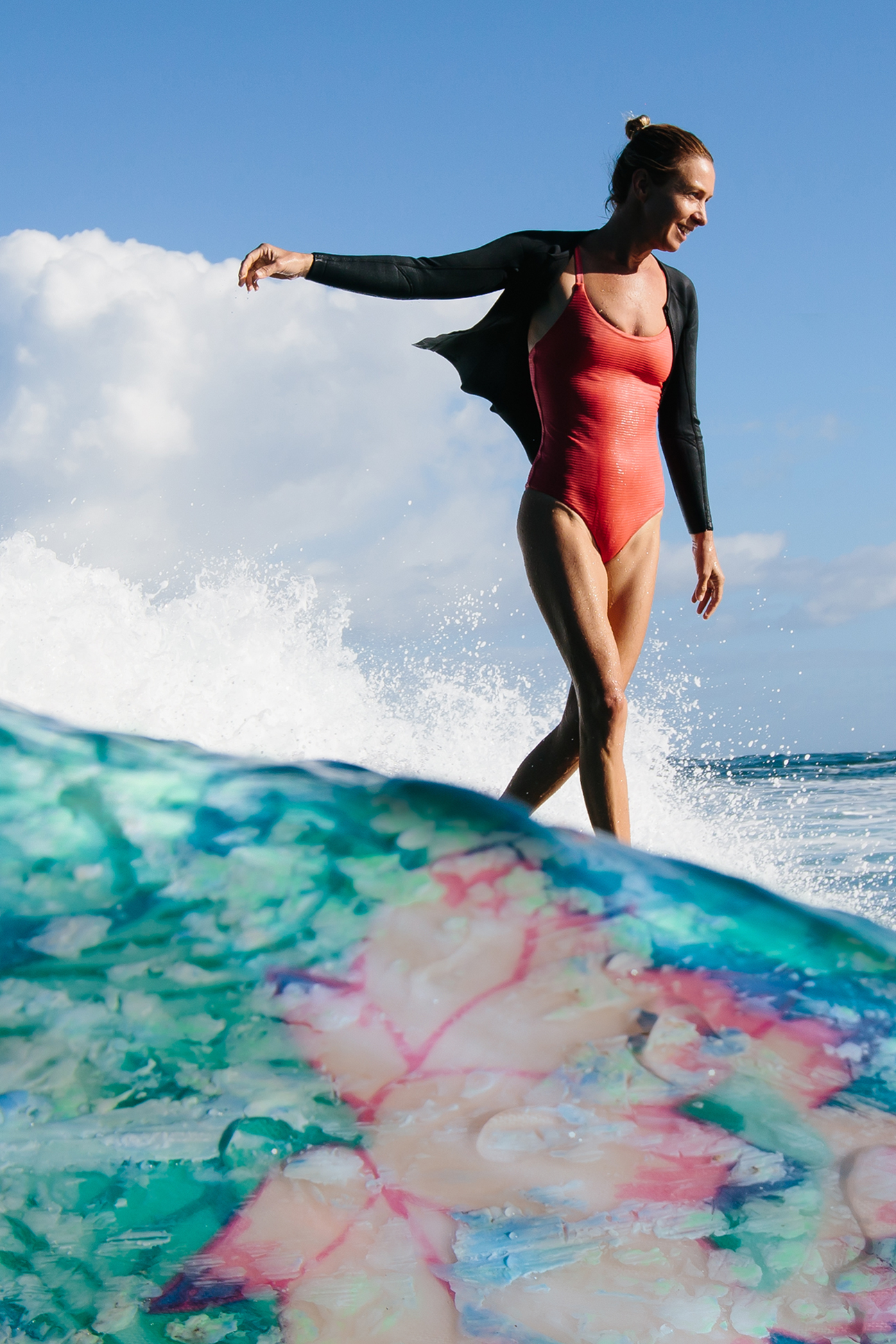

A romantic interlude between surfers gave Kalehuawehe, off Waikīkī, its name, which means “the lehua flower lei removed.” Kamakau writes that Pikoiaka‘alala, a “strikingly handsome” warrior, was surfing at an unnamed break open to commoners like himself, when he was joined by Kahamalu‘ihi, a Waikīkī chiefess, who had left the nearby kapu surf spot of Kapua, reserved for ali‘i. Pikoiaka‘alala was wearing lehua flower lei as he sat in the lineup preening “with a grin and a coy look.” Kicking off a flirty conversation layered with kaona, the hidden meanings Hawaiians weave through stories and songs, Kahamalu‘ihi said, “I think I’d look fine with your lei.” The warrior removed his lei, she tied them around her neck, and thereafter the break was known as Kalehuawehe.
Surfing mele and chants were dedicated to Hawaiian royalty, including the Kingdom of Hawai‘i’s last monarch, Queen Lili‘uokalani, born Lydia Lili‘u Loloku Walania Wewehi Kamaka‘eha in 1838. She fought to restore the integrity of the constitutional monarchy after American residents in the kingdom forced her late brother, King Kalākaua, to sign the 1887 Constitution of the Hawaiian Kingdom, notoriously known as the “Bayonet Constitution” by where an armed militia was used to obtain his signature and prevented Native Hawaiians from voting, placing his government under their control. When Lili‘uokalani gained power, however, she dismissed her brother’s “reform cabinet” and rewrote the constitution. She also wrote many songs, most famously “Aloha ‘Oe” and “Ke Aloha O Ka Haku (Queen’s Prayer).” “Halehale Ke Aloha,” a surfing chant composed in her honor, celebrates how “Kamaka‘eha on the crest, Rides the surf to shore,” writes John Clark, who notes a parallel meaning of the lyrics describes the queen as both the foundation and top of the state, providing guidance and stability. She only reigned for three years, however, before her government was illegally overthrown at gunpoint by the Americans in 1893.
The surfbreak Queen’s in Waikīkī is named for Lili‘uokalani, and she is believed to have written her song “Ahe Lau Makani,” “the soft, gentle breeze,” at Hamohamo, her cottage on the beach. In 1896, her niece and designated heir to the throne, Princess Victoria Kawēkiu Lunalilo Kalaninuiahilapalapa Ka‘iulani Cleghorn, traveled to Washington, D.C. with her aunt and met with President Grover Cleveland, petitioning but ultimately unable to prevent the illegal annexation of Hawai‘i by the U.S. in 1898.
Raised in Waikīkī at her family’s estate, ‘Āinahau, Ka‘iulani loved to swim and surf; one of her surfboards, a slender alaia model made of koa, seven-foot, four-inches long, is in the collection of the Bishop Museum. The princess also loved to surf in outrigger canoe, and in June 1898, following a beach luncheon, travel writer Burton Holmes found himself riding waves with Ka‘iulani in a canoe surf session off Waikīkī. As the boat raced shoreward at 30 miles per hour, Holmes recounted, “There before me is the Princess Kaiulani, her faced aglow with excitement, shouting and paddling frantically, her eyes flashing with the wild pleasure of it all.”


Less than a year later, in March 1899, Ka‘iulani fell ill after being caught in a rainstorm while riding horseback in the mountains of Hawai‘i Island, and died soon after at age 24. One of the many kanikau, or lamentations, written for her evokes the surf site Kalehuawehe as “a poetic symbol of great loss.”
Kalehuawehe, then, is at once the happy place where a surfer lost his lehua lei to a wahine, and the sorrowful place where the loss of Kai‘ulani, who shone in the waves of Waikīkī and white lehua lei, will always be deeply felt. But her joyful presence, too, can be felt in the waves, as evoked in the mele “Lei No Kai‘ulani,” just as the rediscovery of this surfing lineage — the ancient tales, the storied history from Kelea to Kennelly, from Māmala to Moore — reaffirms women’s presence in the ocean today.
As longboarder Jenny Van Gieson told me,“I feel when I’m surfing, I’m surfing with Aunty Rell, and other uncles and aunties I’ve lost.” Mentored as a child by Rell Sunn, the late, beloved Mākaha surfer, lifeguard, and children’s advocate, “When my life gets super hectic, the ocean is the place I go to for release, to feel that connection with the past,” she said.
In the surf, like the queens and commoners of old, we can escape gender-based restrictions and celebrate who we are, and who we are becoming.
The kai is the first playground for Hawai‘i’s children. “We were all little girls, always going to the beach, playing around while my father fished, and then we started using boards, working with the waves,” remembers Macabio, who started surfing at Pohoiki First Bay in sixth grade. “Pretty much we’d just go, learn on our own, a sink or swim sorta deal. You had to watch out — if you didn’t pay attention, the current would push you and you wouldn’t realize until it was too late, and you’d end up on the rocks with wana all over your body,” she laughed. “The fun thing about surfing,” she said, “is it is truly the Hawaiian rollercoaster ride. It’s, like, addicting.”
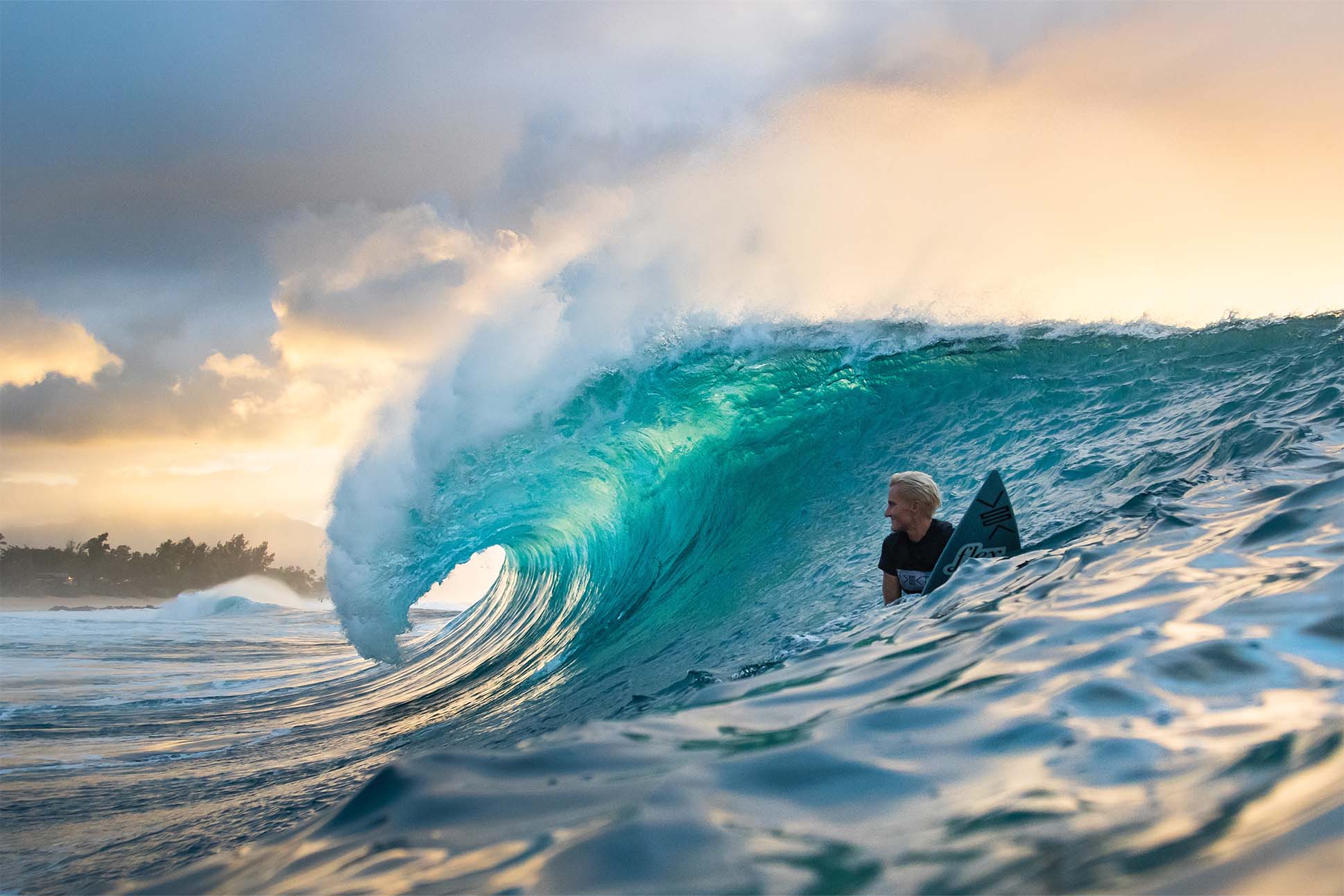

A longtime neighbor of mine, an older man who doesn’t surf, observes that when men paddle out to Tongg’s or Suis they look grim, as if psyching themselves up for battle. Whereas women, he said, look happy and lighthearted, as if they’re going out to play. He adds he sees women mostly paddling out alone, whereas men go out in a posse of bros, or brahs.
Why the difference? he asked.
It’s because a woman’s life, like surfing, is a balancing act. We tend to go out alone because there are fewer of us who surf with less time to meet up with friends. We have to seize the moment, often on the spot, grabbing a quick break from child, elder, and pet care, errands or homemaking duties. Surfing provides “a bit of meditation, takes me out of my zone of worry, all the things, schedules, that come with everyday life,” says Elizabeth Madin, a marine biologist and mother of three. “I’ve got to focus on waves, that’s it. I’m just glad to be out there, doesn’t matter if I get the best wave.”
Madin is also a founder of Surfing Moms, a group of women whose members organize babysitting for its members, taking turns watching everyone’s kids on the beach while the rest ride waves. In addition to getting moms back in the water, the group helps build a network of familiar faces. “When I’m alone, I feel I have to be expressionless, keep to myself,” Madin said. “When I’m out there with friends, I’m not as intimidated..”
“I think it’s changed for me throughout the years,” says Sally Lundburg, a Hawai‘i Island mother, filmmaker, farmer, and teacher. “Now, I’ll take any time I can get in the ocean. Swimming, bodysurfing, surfing, it really doesn’t matter. Just to reconnect with my body and with nature, I can feel renewed by going out on the worst days.”
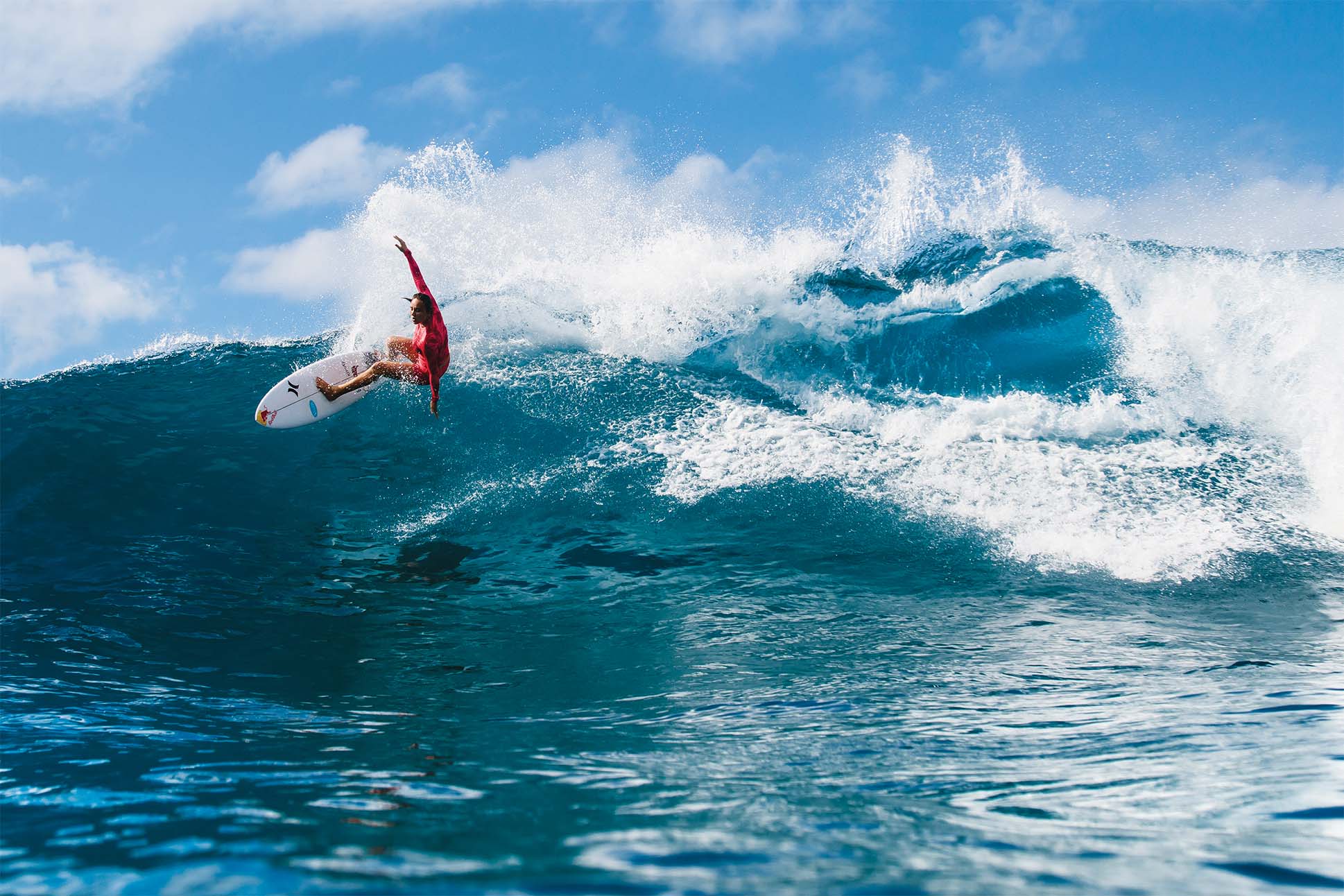

Macabio, also a working mother of two, shares this sentiment. “Surfing feels liberating, like, Oh, I’ve been holding my breath for so long and all of a sudden, I get to release it.” With Lundburg, and other women, she surfed at Waipi‘o Valley until the county suddenly closed the only beach access road in February 2022. Public access has since been partially reopened, as the result of a lawsuit filed by Mālama I Ke Kai ‘o Waipi‘o, also known as MaKa, the community organization Macabio helped form.
For many island women, surfing is a way to perpetuate traditional Hawaiian values and restore one’s sense of self. Karin Amimoto Ingersoll, author of Waves of Knowing: A Seaside Epistemology, writes, “It isn’t until I enter ke kai for he‘e nalu that I am able to connect with my Kanaka heritage.”
For others, it’s a way to bond with loved ones. Many were taught by their fathers, some by their mothers.
And, there are so many more reasons. If you don’t surf, you can try it and add your own. But watch out: The first time you stand up on a board, borne swiftly along by a wave, you could become obsessed.
This article is excerpted from Surfing Sisterhood Hawai‘i: Wahine Reclaiming the Waves by Mindy Pennybacker, published by Mutual Publishing. Pennybacker is a surf columnist for the Honolulu Star-Advertiser and former editor of The Honolulu Weekly.

